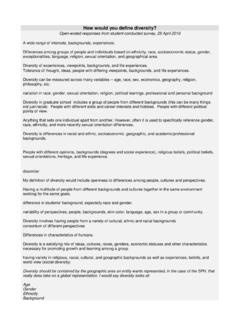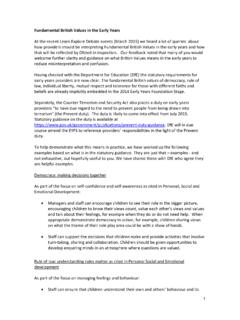Transcription of DEI (Diversity, Equity & Inclusion) Checklist
1 DEI ( diversity , Equity & Inclusion) Checklist1 Directions: Use this Checklist to identify gaps at your organization and inform action for DEI through organizational policies and practices. It is not exhaustive and plans should be customized by each organization. Level 1 Institutional: Robust list of policiesThe policies are categorized in the following domains: Recruitment, promotion and employee evaluations, pay, sexual harassment, flexible work and care. Recruitment & Hiring: Recruitment procedures can be built to be blind, and therefore help to attract and hire the best candidates regardless of the identity/ies they associate with.
2 Policies and actions2 to take include: Remove bias from job descriptions. Wording in job descriptions can impact whether more females or males apply ( research shows that masculine adjectives like superior, competitive, and determined, result in less female applicants). All qualifications should directly tie to duties performed on the job. Expand your sourcing networks. Look at diversity -oriented job groups, partner with diversity organizations and connect with diversity -oriented groups at universities. Also, develop outreach programs with educational institutions beyond elite universities and ensure more equitable focus on under-represented groups.
3 Job advertisements can be shared with these contacts. Conduct blind resume screening. Gender and ethnicity of names are known to have an impact on resume screening. Removing names can enable reviewers to avoid potential bias. Define objective hiring criteria. Get hiring teams on the same page ahead of time to prevent unspoken or subjective criteria from appearing late in the evaluation stages. Create diverse interview teams ( , sought after skills). Structure interview teams based on who can evaluate candidates objectively and who would make the candidate feel comfortable. Be aware of affinity bias which is the preference for people like me.
4 Consider having interviewers do mock interviews with existing employees to improve their own skills. For technical applicants, consider blind code reviews (as opposed to whiteboard interviews , which can create extra stressors for people from underrepresented groups). In blind code reviews (modeled on blind auditions that orchestras hold) candidates are given a problem to complete at home. Ensure all personal identifies are wiped from candidate s assignment and evaluate against a standardized process ( , Checklist ). Consider allowing candidates to complete the assignment in the office if preferred, as this may be preferred for candidates with caretaking responsibilities.
5 Utilize behavioral-based interviewing that is standardized based on the objective hiring criteria. Ask potential hires the same questions. Develop an interview script that is used for each candidate for a certain job. This can help avoid confirmation bias which is when someone forms an opinion and interprets new evidence as a confirmation of that belief (such as an interviewer starting with preconceived opinion of a candidate and asking questions geared to confirm that belief). Create more pathways for contractors, temps and vendors to become full-time employees. Employee evaluations & promotions: Policies and actions include3: Commit to transparency in how candidates are leveled and promoted.
6 Use a uniform evaluation cycle. Conducting performance reviews of all employees simultaneously helps supervisors dedicate ample time to write good evaluations and ensure consistency among all employees. A uniform evaluation cycle allows management to review individuals contributions to organizational goals. Ensure managers are given adequate time to do their evaluations. The more rushed people are, the more they rely on stereotypes. Assess employee performance based on standard decisive factors, aptitude and metrics that are consistent across other employees in similar job functions. This ensures that employee reviews are fair and objective.
7 Consider having and ensuring managers maintain a regular ( monthly or bi-monthly) performance log for each subordinate.* A performance log should be set with clear, objective standards of what is doing one s job and going beyond one s job based on the job description of the current role and the role at the next level of the hierarchy. An accountability mechanism can ensure managers are completing performance logs (such as a digital tracker when performance logs are saved). Train managers / supervisors on how to provide concrete and objective examples of feedback that are backed by facts from the performance log notes.
8 * Avoid personal critiques and exaggerations. Provide training to manager to counteract bias in performance reviews.* *These policies and practices link to level 2. Pay: Policies and actions4 to take include: Do not ask for previous salary history or have applicants name a salary when hiring. If individuals have lower initial salaries, basing wages off salary history can trap them into lower wages and lower lifetime earnings. Create narrow pay bands, as women are less likely to negotiate the first offer. Create robust pay Equity processes grounded in statistical analysis with annual reviews, including bonuses.
9 Annually evaluate pay data and bonuses controlling for observable factors such as level of position, years of experience, education, etc. Include contract workers, temps and vendors as part of the pay Equity goals and process. Provide managers with this data, where they stand in terms of pay for individuals of different identities ( gender, race/ethnicity), as well as market information on employment in the technology industry. Inform employees of low, median and high pay ranges for particular roles. Employees understand why they are paid within the range, managers can discuss with employees why they are at a certain pay range level, and employees can be empowered to ask for raises when they feel deserving of them.
10 Implement formal remediation protocols. Formal remediation protocols are important in ensuring pay Equity processes are implemented appropriately and that manager discretion doesn t promote inequality. Publish compensation levels (including bonuses and Equity , across all roles and job categories, broken down by race and gender) and pay bands. Doing so, will hold the organization accountable. Further, employees will think the organization is bought into practices given this accountability which can improve recruitment, morale, organizational commitment and more. Flexible work: Flexible working policies provide support to caregivers (often women, who do most unpaid care work and therefore face time burdens to complete care responsibilities and professional responsibilities) and can reduce care burdens for female caregivers in the case of male partners taking flexible work to assist with care work.








